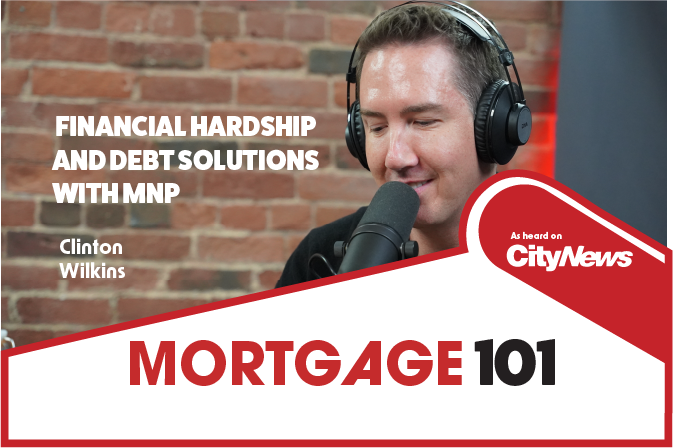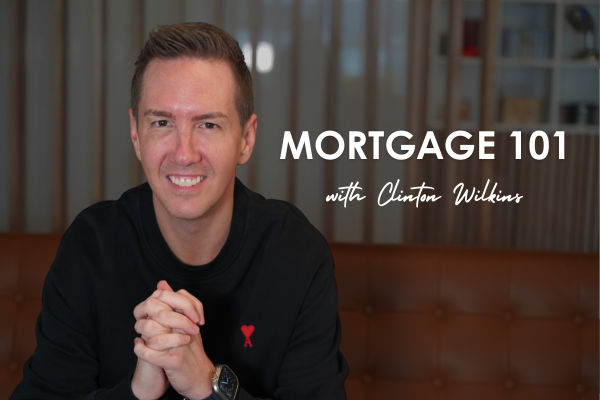Todd Veinotte and Clinton Wilkins discuss the evolving landscape of mortgage lending, highlighting its complexities and the importance of staying informed.

Mortgage 101 – : Financial Hardship and Debt Solutions with MNP
This segment Clinton and Todd are joined by Tina Powell, a licensed insolvency trustee and Senior Vice President with MNP limited. They discuss debt trends in Atlantic Canada, financial hardship and debt solutions.
Debt Trends in Canada with a Focus on Atlantic Canadians
Todd Veinotte
All right mortgage one-o-one your guide to homeownership with Clint Wilkins. That song my friend goes back to when I was just a young man in high school, probably before junior high. What do you think?
Clinton Wilkins
I mean, you’re still a young and let’s be honest,
Todd Veinotte
Well, you know what I’m talking about back in my formative years, as they say,
Clinton Wilkins
I mean, your formative years were good years, you know.
Todd Veinotte
Maybe they weren’t so good. I think when we look into things through different lenses of being, It’s not what you remembered, I don’t know, what’s that sentimental? Sometimes it’s not reality. What do you think?
Clinton Wilkins
Yeah, sometimes it’s not. I mean, I guess you just have to live your best life all the time.
Todd Veinotte
Live your best life all the time. Sounds good. And mortgage one-o-one, your guide to homeownership where one of our goals, and I think we achieve it, is to educate people as much as we possibly can. And we have the opportunity to do that with guests from time to time, of course, including today.
Clinton Wilkins
And I’m so excited to welcome our next guest. We have Tina Powell from MMP and we’re gonna have her talk to us a little bit about debt trends. And, what happens if you own a house and you can’t refinance? What if you’re just not in a good place? Or, if you don’t own a home and you can’t leverage that equity. What should you do with your debt? I think we have Tina on the line. Hello. Hi, Tina. Thanks for joining us!
Tina Powell
My pleasure.
Todd Veinotte
Hi, Tina.
Tina Powell
Hi.
Clinton Wilkins
Maybe give us a little intro about who you are and what your role is with MNP.
Tina Powell
So hi, my name is Tina Powell. I’m a licensed insolvency trustee and Senior Vice President with MNP limited. I’m both based out of the Dartmouth Nova Scotia office, and we help individuals and businesses who are experiencing a financial crisis.
Clinton Wilkins
Excellent. We always hear in the media that Canadians are just so indebted. Tina, do you have any stats around this hearsay? What does that all look like?
Tina Powell
Well, sure, we know that Atlantic Canadians seem to be leading the pack in several of the statistics that the latest survey released. Mainly Atlantic, Canadians are the most likely to regret the debt that they’ve taken on with 70% concerned about their ability to repay their debt. Those are some pretty significant statistics.
Clinton Wilkins
Yeah, definitely.
Financial Hardship and Debt Solutions
Todd Veinotte
I guess the trend is inflationary challenges, like we’ve never seen, at least not in my lifetime. We’ve heard of high interest rates in my lifetime, I guess in the 80s interest rates were sky high, but for not this extended period of time. So there’s a bit of a perfect storm of challenges out there right now for people.
Tina Powell
Oh, for sure. We see that with the holiday bills coming in and mortgage renewals on the horizon, the surge in cost of living, many are at a loss to be able to cope, they’ve basically taken all necessary measures they can and reduced discretionary spending in their budget. But for many, there’s just simply no room for any further cuts.
Clinton Wilkins
We’re certainly seeing this with clients coming to see us every day, Tina, so many clients that are at renewal, are wanting to do a refinance, maybe not just due to their indebtedness, just due to the amount of payments. But you know, the challenge that we sometimes have is that there has to be enough equity in the property and we sometimes see people that are coming up for renewal, and there’s just not enough equity to refinance. What is the message that you want to tell those people; are there other options, Is there hope? What should they do, if they really are underwater? What if there’s not enough money to go around every month, and they’re robbing Peter to pay Paul?
Tina Powell
Sure. Well, by the time people often seek our assistance, they have been dealing with their debt for years and sometimes even decades, paying thousands of dollars in interest, many of these individuals can benefit greatly from a conversation with a licensed insolvency trustee, that conversation can be simply a review of their budget or putting a budget together, or setting up an informal debt repayment plan. But many of these households will require the services of a licensed insolvency trustee. But there are options available, and many will benefit from maybe falling into personal bankruptcy or doing a proposal to their creditors. And those are the kinds of things that licensed insolvency trustees can provide to those who are experiencing financial difficulty.
Todd Veinotte
Describe the demographics. I’m not sure if they’ve changed or not with the type of people that you’re seeing. Are you seeing older people, younger people, people with different job backgrounds, different professions? I’m assuming that that’s probably happening. Similarly to us hearing that more people are needing other services like food banks. Does this track? Let’s dive more into the demographics and the type of people that find themselves in the situation where they can use your services.
Tina Powell
You know, there’s no real trends. We see people from all different professions, all different income levels, and, and all different financial situations who come in, and most often, they’re carrying large amounts of unsecured debt, that they’re unable to pay with many that have already been experiencing extreme collection pressure from the creditors, and in some cases are having their wages garnished.
Bankruptcy and Consumer Proposals in Nova Scotia
Clinton Wilkins
Right? Yeah, that can be a very scary time. Often the people that I’m seeing, their credit is usually good. Usually people are making their payments. But I always think of what if you get to that point where you can’t make your minimum payment, if you have collections, if you have judgments, then should you already have been talking to someone that’s a trustee? You know, what I’m most curious about is what’s the difference between a bankruptcy and what’s the difference between a consumer proposal? And maybe just tell us that first, Tina, and I’ll have a follow up question.
Tina Powell
Sure. Well, there are some notable differences. A consumer proposal is a formal debt settlement that requires approval from the unsecured creditors. And, it’s basically just a simple majority of unsecured creditors accepting the formal offer put forth by the trustee, that is binding on the total unsecured creditor pool. Additionally with the consumer proposal, you get to keep your assets, you file your own tax returns, you’re not required to report your income monthly, like you would be in the bankruptcy scenario. It’s a lot easier on your credit rating, and you have a set monthly payment amount. On the other hand, bankruptcy can be much harder on your credit score, and the trustees responsible to file your tax returns. You basically have to report your income monthly for a period of time based on your income level, and if you’ve had a prior bankruptcy or not. And in a bankruptcy, only assets that are exempted by federal or provincial legislation are able to be maintained by the individual.
Todd Veinotte
What are those, sorry to interrupt you, but what are those assets that are protected?
Tina Powell
Sure. So in Nova Scotia, an individual can keep their household items, they can keep their RSPs, except for any contributions in the last 12 months. Life insurance policies with preferred beneficiaries are exempt. A vehicle with up to $6,500 in value, tools to trade up to $7,500 in value, but in both a consumer proposal and a bankruptcy, there are also some similarities as well.
Todd Veinotte
Which are?
Tina Powell
Both of them are a formal process that’s used to repay your debt. And, both offer legal protection from your creditors for things like garnishments and collection calls. And, there’s two counseling sessions that are mandatory in consumer proposals and bankruptcy and both have the option for individuals who want to maintain a secured debt for something like a home or vehicle. Basically they still have the option to maintain that debt so they can keep that asset, if that’s what they choose.
Clinton Wilkins
Would you say a consumer proposal might be someone who’s more asset rich, but cash poor, and bankruptcy would be for someone that has maybe a little less assets? Like, which type of process would be good for what type of person?
Tina Powell
Well, a consumer proposal is definitely a trend these days, people are loving consumer proposals. There’s been a huge surge of proposals over the last few years. But to file a proposal, one of the most important key factors is that you have to have positive cash flow. So if your budget is underwater, then maybe a proposal may not be the best option. But that’s when we would look at a bankruptcy. But in most cases, just working through a budget plan with these households, and freeing up some of the debt payments, will enable these individuals to be able to file a consumer proposal to avoid bankruptcy.
Clinton Wilkins
I read recently that the amount of bankruptcies across the country is up, and they’re up also in Nova Scotia. Do you have any stats related to that? Tina? Like are you seeing more customers now?
Tina Powell
Yes, we’re definitely seeing an uptick in individuals needing our services. Based on the November 2023 data, personal insolvencies are up 26.2% in Nova Scotia. So that’s a pretty significant jump for sure.
Todd Veinotte
When people do go through the filing of the bankruptcy, once filed, what is the expectation? Is it a year of payments? Is that correct? Is that how it works?
Tina Powell
Well, for the first time bankrupt, depending upon your income, there is a possibility that you could get discharged within nine months. But if your income is higher than the income guidelines set by the superintendent of bankruptcy, you could be looking at 21 months, for second and third bankruptcies, you’re looking at two to three years, depending on your income as well.
Todd Veinotte
Often you see second and third bankruptcies, man oh, man, that’s gotta be brutal.
Tina Powell
To be completely honest, we see a lot of multiple filings for individuals.
Clinton Wilkins
You know what, that’s not good news. I always say, do it once, get your situation cleaned up, and don’t do it again. And I always say that if you’ve been through a consumer proposal, or if you’ve been through a bankruptcy, make sure you’re making all your payments going forward. And don’t do it again. Obviously, we know life events happen, you know, people lose their jobs. There’s health issues. There’s matrimonial breakdown. And I think you can probably confirm, Tina, if that’s the main cause or not. But I would say, don’t do that, again, obviously, if it can be avoided.
Tina Powell
Yeah. And I agree, you’re totally right, you hit it right on the head on the nail. Clinton, that those are some of the main reasons. Now we’re seeing a little bit of a trend towards the cost of living and the rising interest rates being some of the reasons that individuals are filing. But when we do have somebody that’s come in ahead, maybe filed a previous bankruptcy, we really do our best to avoid a second filing of a bankruptcy and try to do a consumer proposal, which is much easier on their credit rating, of course.
Todd Veinotte
Tina, thank you so much. You’ve been a great guest. Good insight. Appreciate it.
Tina Powell
My pleasure. Thank you again for having me on.
Todd Veinotte
Lots of good information there. Right? For sure. Obviously, okay. Lots more to get to mortgage one-o-one your guide to homeownership. We’ll be right back.


